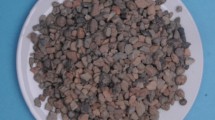Abstract
An experimental program was arranged to investigate the relationship between shear deformation and pinching in lightweightaggregate reinforced concrete beams under cyclic loading. Lightweight-aggregate reinforced concrete beams and their connection to column were selected for the purpose of this study and their flexural and shear behaviors experimentally were investigated. Damaged part of the beams was determined after the test. Using the results, values of beam tip displacement, curvature, and shear distortion in the plastic hinge region of beam were measured and components of shear and flexural deformation of the beam were calculated. Investigations were also performed on the effect of damage extension at the beam-column connection joint as well as effect of shear deformation on pinching increase. It was concluded that, in the lightweight-aggregate reinforced concrete beams in which the damaged part was extended to the beam-column joint, pinching was higher and also shear deformation has a larger contribution of the total beam deformation.
Similar content being viewed by others
References
ASCE-ACI Committee 445 (1998). “Recent approaches to shear design of structural concrete.” Journal of Structural Engineering, Vol. 124, No. 12, pp. 1375–1417, DOI: 10.1061/(ASCE)0733–9445(2000) 126:7(853).
ACI 318 (2008). Building code requirements for structural concrete (ACI 318-08) and commentary, Farmington Hills, Ml: American concrete Institute.
Branson, D. E. and Trost, H. (1982). “Unified procedures for predicting the deformation and centroidal axis location of partially cracked non pre stressed and pre stressed members.” ACI J., Vol. 79, No. 2, pp. 119–128.
Celebi, M. and Penzien, J. (1973). “Experimental Investigation into the Seismic Behaviour of Critical Regions of Reinforced Concrete Components as Influenced by Moment and Shear.” Report No. EERC 73–4, Earthquake Engineering Research Centre, University of California, Berkeley, California, 166 pp.
Cervenka, V. (1985). “Constitutive model for cracked reinforced concrete.” Journal of the American Concrete Institute, Vol. 82, No. 6, pp. 877–882.
Elmenshawi, A., Brown, T., and Loov, R. (2009). “Behaviour of flexural plastic hinges under high seismic shear with consideration of concrete strength.” Canadian Journal of Civil Engineering, Vol. 36, No. 11, pp. 1711–1721, DOI: 10.1139/L09-099.
Eom, T. S. and Park, H. G. (2013). “Evaluation of shear deformation of reinforced concrete members subjected to cyclic loading.” ACI Structural Journal, Vol. 110, No. 5 pp. 845–854.
Hsu, T. T. C. (1993). Unified Theory of Reinforced Concrete, CRC Press, Boca Raton, FL, 313 pp.
Ichinose, T. (1992). “A shear design equation for ductile r/c members.” Earthquake Engineering & Structural Dynamics, Vol. 21, No. 3, pp. 197–214, DOI: 10.1002/eqe.4290210302.
Jeong, J. P. and Kim, W. (2014). “Shear resistant mechanism into base components: Beam action and arch action in Shear-Critical RC Members.” International Journal of Concrete Structures and Materials, Vol. 8, No.1, pp. 1–14, DOI: 10.1007/s40069-013-0064-x.
Loov, E. (1998). “Review of A23.3–94 simplified method of shear design and comparison with results using shear friction.” Canadian Journal of Civil Engineering, Vol. 25, No. 3, pp. 437–450, DOI: 10.1139/l97-101
Mehrabani, R. V. and Sigrist, V. (2015). “Elongation of reinforced concrete plastic hinges subjected to reversed cyclic loading.” J. Struct. Eng., ASCE, Vol. 141, No. 8. pp. 04014188–1–04014188–10, DOI: 10.1061/(ASCE)ST.1943-541X.0001159.
Priestley, M. J. N., Verma, R., and Xiao, Y. (1994). “Seismic shear strength of reinforced concrete columns.” Journal of Structural Engineering, Vol. 120, No. 8, pp. 2310–2328.
Ramirez, J. A. and Breen, J. A. (1991). “Evaluation of a modified truss model approach for beams in shear.” ACI Structural Journal, Vol. 88, No. 5, pp. 562–571.
Salonikios, T. N. (2007). “Analytical prediction of the inelastic response of RC walls with low aspect ratio.” Journal of Structural Engineering, Vol. 133, No. 6, pp. 844–854, DOI: 10.1061/(ASCE)0733-9445 (2007)133:6(844).
Song, J.-K. and Pincheira, J. A. (2000). “Spectral displacement demands of stiffness and strength degrading systems.” Earthquake Spectra, EERI, Vol. 16, No. 4, pp. 817–851, DOI: 10.1193/1.1586141.
Spurr, S. D. and Paulay, T. (1984). “Post-Elastic Behavior of Reinforced Concrete Frame-Wall Components and Assemblages Subjected to Simulated Seismic Loading.” Rep. 84–19, Department of Civil Engineering, University of Canterbury, Christchurch, New Zealand.
Taylor, H. P. J. (1974). “The fundamental behavior of reinforced concrete beams in bending and shear.” Detroit, MJ: ACI SP-42, pp. 43–77.
Ueda, T., Sato, Y., Ito, T., and Nishizone, K. (2002). “Shear deformation of reinforced concrete beam.” Translation from Journal of Materials, Conc. Struct. Pavements, JSCE, Vol. 56 No. 711.
Vecchio, F. J. and Collins, M. P. (1986). “The Modified compression field theory for reinforced concrete elements subjected to shear.” ACI Structural Journal, Vol. 83, No. 2, pp. 219–231.
Author information
Authors and Affiliations
Corresponding author
Rights and permissions
About this article
Cite this article
Aghamohammadzadeh, F., Afshin, H. & Nekooei, M. Experimental Evaluation of Relationship between Shear Deformation and Pinching in Lightweight-aggregate Reinforced Concrete Beams. KSCE J Civ Eng 23, 173–179 (2019). https://doi.org/10.1007/s12205-018-0555-z
Received:
Revised:
Accepted:
Published:
Issue Date:
DOI: https://doi.org/10.1007/s12205-018-0555-z




